I am writing this post on my last night of a three and a half week whirlwind trip a friend and I took to both New Zealand and a small part of southern Australia including Tasmania. We’re in Melbourne now for the third time just as we were in Christchurch on New Zealand’s South Island for three times, one more than anticipated because of the horrific events that took place in that city on March 15th when fifty people were tragically killed in a terrorist attack. More on that day in a future post.
We’d arrived in Christchurch late on March 6th but only saw the inside of a restaurant before collapsing for the night. As you most likely remember, devastating earthquakes in 2010 and 2011 destroyed much of the city’s city center with one of the worst hit spots being Cathedral Square and its neo-Gothic Cathedral in the latter earthquake. The tower of the cathedral collapsed and aftershocks cracked the whole cathedral like a plate. No lives were lost there, however.
Diane and I only had planned to spend a short time in Christchurch on the morning of March 7th because there wasn’t much ‘to see’ after so much of the city center had been destroyed. We didn’t want to leave the South Island’s largest city, however, without taking time to visit the Transitional Cathedral or what has become known as the the Cardboard Cathedral thanks to the predominantly cardboard structure designed by Japanese ‘emergency architect' Shigeru Ban who had designed a cardboard church after the Kobe earthquake.
A little more than two years after the February, 2011 earthquake, Christchurch’s residents had a new cathedral to worship in. It was made of cardboard, local wood, steel and a strong polycarbonate roof. It was built to within 130% of the then current New Zealand earthquake code to make it very safe.
A view looking to the back of the church:
I have been to a lot of very powerful memorials over the years and this one was very different from those that were clearly permanent in nature and where obviously a lot of money had gone into them. The variety of chairs honoring the earthquake victims in Christchurch that had been collected and painstakingly painted white and set up in this corner near the cathedral was as heart wrenching as many other memorials marking a tragic time in a community. The individuality of each chair paid tribute to the uniqueness of each person represented.
Overlooking the rocky coast and the lake was the Church of the Good Shepherd, described as a 'sacred place in a heritage natural landscape.' Unlike churches I'm familiar with, this one closed in particularly bad weather. The sign indicated the modest stone church was built firstly to glorify God, and secondly as a memorial to the district's pioneers. "It embodied the essential qualities of the early settlers who endured the tough environment." I liked how it welcomed people of all faiths to sit quietly, pray and meditate.
After warming up in the shops in the small community that has sprung up right by the lake, we headed toward the second of the two Caribbean-blue lakes, Lake Pukaki.
We’d arrived in Christchurch late on March 6th but only saw the inside of a restaurant before collapsing for the night. As you most likely remember, devastating earthquakes in 2010 and 2011 destroyed much of the city’s city center with one of the worst hit spots being Cathedral Square and its neo-Gothic Cathedral in the latter earthquake. The tower of the cathedral collapsed and aftershocks cracked the whole cathedral like a plate. No lives were lost there, however.
Diane and I only had planned to spend a short time in Christchurch on the morning of March 7th because there wasn’t much ‘to see’ after so much of the city center had been destroyed. We didn’t want to leave the South Island’s largest city, however, without taking time to visit the Transitional Cathedral or what has become known as the the Cardboard Cathedral thanks to the predominantly cardboard structure designed by Japanese ‘emergency architect' Shigeru Ban who had designed a cardboard church after the Kobe earthquake.
A little more than two years after the February, 2011 earthquake, Christchurch’s residents had a new cathedral to worship in. It was made of cardboard, local wood, steel and a strong polycarbonate roof. It was built to within 130% of the then current New Zealand earthquake code to make it very safe.
The triangle-shaped stained glass front paid tribute to the cathedral's original iconic rose window.
The design was brilliantly simple with waves of cardboard tubes that immediately drew our eyes toward the cross and altar. I read that at full capacity, it seats nearly 700 people yet there still seemed a sense of space and intimacy within. It was amazing to hear a volunteer guide tell us the polished concrete floor was laid in just one night.
The guide explained the chairs had been recycled and that the only steel was on the beams that connected the cardboard tubes for greater strength. Designed to last for at least fifty years, the Transitional Cathedral will eventually become a parish church when the permanent cathedral is rebuilt in Cathedral Square. The previous one, experts now realize, had been constructed on a drained swamp and was therefore very unstable. The new cathedral will be rebuilt as closely as possible to what it was.
It was only on closer examination that we realized that metal containers comprised the sides of the building; they provided stability to the building as well as being used for church offices.
A simple chapel was off to one side near the front and was used for midday prayer.
The containers were very evident once we walked around to the side of the building.
A block away was a tribute to the 185 people who lost their lives in the 2011 earthquake. Rather incongruously, 185 Empty Chairs as the exhibit is known, were packed very closely together in between two downtown parking lots. People coming to visit were welcome to reflect on the tragic loss of life by sitting down on any of the wide variety of chairs that had each been painted a stark white.
I read about the meaning behind the concept of the 'empty chair' which depicted the loss of someone and the fact that it's been used repeatedly across time and culture. Artist Luke Fildes drew The Empty Chair in 1870 when he learned about the passing of Charles Dickens for whom he'd illustrated a book. The idea was also inspiration to Vincent Van Gogh in 1888 when he portrayed the differences between his temperament and approach to art and life, and that of fellow artist Paul Gaugin in two separate paintings.
More recently, public memorials have made use of empty chairs to symbolize the loss of lives as in New York City's Bryant Park when 2,735 empty chairs faced south toward the fallen towers before the 10th anniversary of the September 11th terrorist attacks, with each chair honoring one person who died in the attacks.
In the same way, the victims of the 1995 Oklahoma City bombings are remembered at an outdoor memorial with their names written on chairs made of bronze and glass. In Krakow, Poland, a memorial to the Jews of the Jewish Ghetto was revealed in December, 2005 and included 33 steel and cast iron chairs standing in a square and at tram stops. Steven and I have spent time at both moving memorials.
I recommend you read this eloquent piece about love and loss. It certainly resonated with Diane whose husband, Ron, passed away almost two years ago. Click on the image to make it bigger.
Writing this shortly after the slaughter at two mosques in Christchurch makes me wonder what sort of memorial will be in place at some point in the presumably not-too-distant future to remember those fifty people who died in the senseless carnage.
After that somber visit, Diane and I headed south toward Twizel, located in the south central part of the South Island, and our final destination for that night. We found a perfect place to stop in the small town of Ashburton that fueled both our passions: coffee for her and a yarn shop for me! Thanks to the great advice of Suellen, a dear friend and knitting buddy back home, I'd brought yarn with me and have been knitting up a storm already thanks to the many hours spent in the car traveling such great distances.
The cafe/wool shop even had a cute bathroom sign to add to my 'collection' of same!
We'd been driving for about 3.5 hours and we both thought this was the prettiest view we'd seen since leaving Christchurch. It was very cloudy as we drove next through the mountains and toward the western part of the island. We hoped the temperature would clear up before we reached the Caribbean-blue lakes on the Starlight Highway as we'd hoped to picnic there.
As I mentioned in a previous post, one very handy thing for travelers in New Zealand is the availability of clean and generally very attractive public bathrooms in every town. This one was too adorable not to take a photo of at the Lake Tekapo car park. As you can see from my attire and windswept hair, picnicking was not an option!
The construction of the Lake Tekapo Foot Bridge was a major undertaking with huge steel tubes having to be buried deep into the river bed before a local stonemason covered concrete tubes with stones from the lakeside. The bridge was constructed in Christchurch and transported in October of 2015 in seven sections down to Lake Tekapo. With the help of a 550-ton capacity crane, the sections were placed on the piers.
We knew intellectually the bridge was very strong but to feel it move under our feet because of the fierce winds as walked across was rather disconcerting!
As southern New Zealand is a great draw for astronomers, there were plenty of information boards along the path describing the stars. There was even a Lake Tekapo Solar System Challenge but we didn't want to take the time to read about it as it was too damned cold!
We had to tread carefully as we made our way down to the shoreline as it was so windy and the unevenness of the rocks made it quite treacherous for people who were less than sure-footed, i.e. myself!
The lake was certainly as gorgeous as its billing but fierce winds howled the entire time which didn't make us want to dally long.
This was the only place all trip I was thankful I'd brought my fleece headband as it was so chilly.
After warming up in the shops in the small community that has sprung up right by the lake, we headed toward the second of the two Caribbean-blue lakes, Lake Pukaki.
Thought but a ten-minute drive away, it was far less congested, there were no shops, no constant din of construction noises - just a lookout with a lovely path near the shore. It was hard to envision a more beautiful place to be unless you were there with the one you love, Steven.
Fortunately, the winds here were almost non-existent so we had a wonderful stroll along the beach and through the woods. We had to content ourselves with just that as it was getting to be late afternoon.
It was fun looking more closely at plants that we'd seen along roadsides as we sped along in the car earlier.
Steven and I've never been to the Caribbean so these views just whetted my appetite to fly off to that part of the world some day if we can.
New Zealand has some of the most beautiful native grasses I've seen anywhere.
All over New Zealand were these constant reminders to remind international drivers to stay left. They came in particularly handy when leaving car parks.
As we whizzed by, we kept seeing these attractive blue flowers or possibly weeds along the highway. As it'd begun to drizzle again, the colorful thingamajigs made us smile.
Having such a big apartment in tiny Twizel was a bit lost on us even though we were going to be there for two nights. It was more suited to a family with four single beds in one room and a queen in the living/dining area. We did enjoy being able to spread out although it was no fun lugging suitcases up the steps and listening to noisy neighbors below us!
I thought we might cook some meals in the apartments we rented but the only 'cooking' we did the whole trip was to make tea, coffee and ham sandwiches for our next day's lunches! Neither of us want to see a ham sandwich for a long time, that's for sure; for some reason, the ham always looked far more appealing than turkey, salami, etc in the grocery stores.
Next post: Hiking in Aoraki/Mt. Cook National Park where New Zealander Edmund Hillary trained before he ascended Everest in 1953.
Posted on March 24th, 2019, from Melbourne, Australia, just hours before flying home to my beloved Steven in Denver.




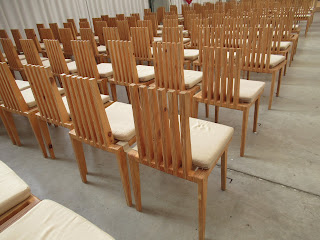

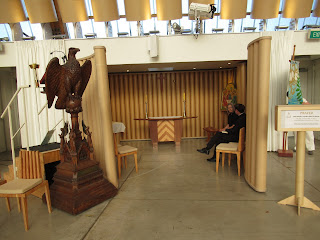

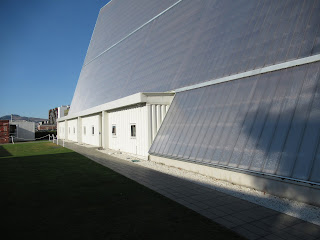

















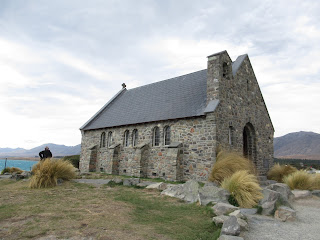


























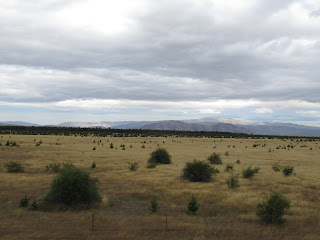


No comments:
Post a Comment